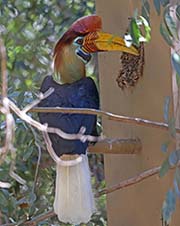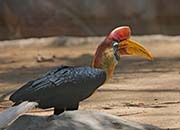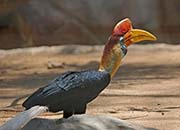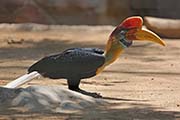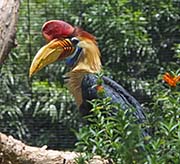Knobbed Hornbill - Aceros cassidix
| Length | |
| Weight | |
| Clutch Size | |
| Chicks at birth | |
| IUCN Conservation Status | |
Continents: |
The Knobbed Hornbill is also known as the Sulawesi Wrinkled Hornbill and the Red-knobbed Hornbill. It is one of the largest of the 54 species of hornbills. This Hornbill is endemic to the islands of Indonesia. Their most distinctive feature is their large yellow bill with orange ridges and their red casque on top of the bill. Their body is mostly black, with a white tail, pale blue skin around the eyes and shades of blue skin at the throat. The male has a buff colored face and neck. The female has a black face and neck, a yellow casque and is smaller than the male. Both have dark colored feet.
The Knobbed Hornbill is the faunal symbol of South Sulawesi province.
Diet: The diet consists mainly of fruits especially figs. They will also eat some small invertebrates.
Courtship: It is believed that Hornbills court and stay together throughout the year building the strong pair bond needed for the male to take care of the female and chicks during incubation and fledging. Some of the courting behavior include the male enticing the female with presentations of cherry-red figs. There is also mutual preening.
Nesting: Nests are natural cavities located in large trees. The female seals herself inside the cavity using a mixture of feces, food and feathers to seal off the entrance except for a narrow slit. This slit is just large enough for the male to pass food through and for her to defecate outside the nest. While in the nest, the female will lay 2-3 white eggs and will stay inside the nest until the chicks fledge. During this whole time (approximately 4 months) the male will provide all food. As with other hornbills, the Knobbed Hornbill is believed to be a monogamous species.
Habitat and Range: An Indonesian endemic, the Knobbed Hornbill is distributed in the tropical evergreen forests of Sulawesi, Buton, Lembeh, Togian and Muna Island. They primarily inhabit lowland forests and forest edges.
Vocalization: The casque on top of the Knobbed Hornbill's head is believed to help the hornbill produce the loud barking sounds that they make.
Plumage/Molt The female undergoes a complete molt while inside the nest cavity. Males and non-breeding females go through a sequential molt.
Migration: Knobbed Hornbills are not migratory but will range over a wide range of land looking for food.
Tongue/feet: Their tongues are too short to manipulate food, so they jerk they head back to get the food from the tip of their beak down to their gullet.
Bibliography:
- http://en.wikipedia.org The Free Encyclopedia, Accessed July, 2012
- http://www.zoo.org Woodland Park Zoo, Seattle, WA, Accessed July, 2012
- http://www.lazoo.org Los Angeles Zoo, CA., Accessed July, 2012
- http://www.avianweb.com/ Avian Web, Accessed July, 2012
- http://www.sandiegozoo.org/animalbytes/ San Diego Zoo, Accessed July, 2012
